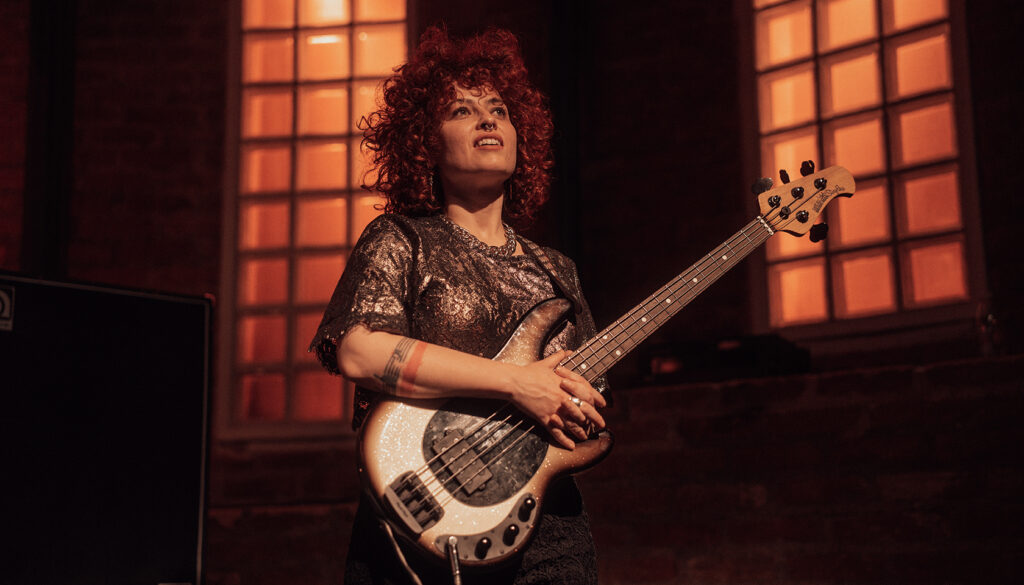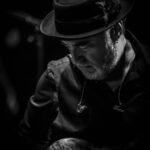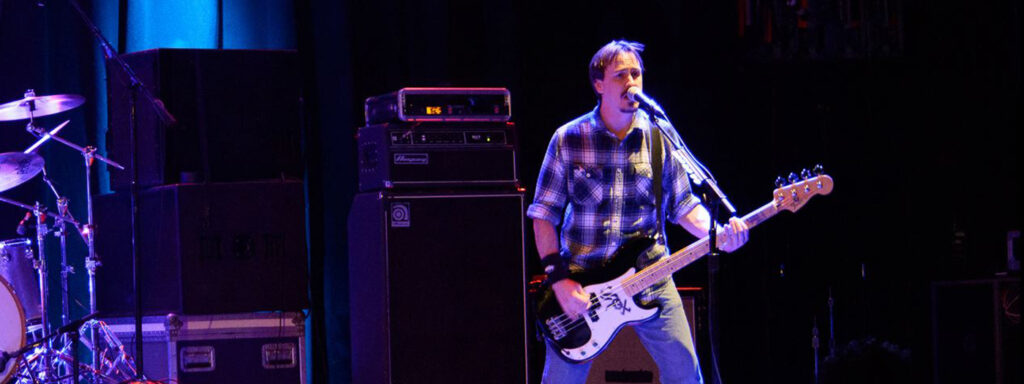The Ultra Lo
NEWS
Keeping the Floor – Pops Magellan
By: Dino Monoxelos

Photgraphy by Lucas Parisi
One of the coolest aspects of my gig here at Ampeg has been meeting and working with young, up-and-coming players from around the globe. Ampeg has always been steeped in tradition, and that naturally includes working with our legacy artists—many of whom have supported Ampeg long before I joined the brand. Collaborating with these players, and becoming close friends with some of the very heroes who inspired me, has been one of the most rewarding parts of being here. It kinda makes it feel like it’s not a job at all.
At the same time, connecting with younger players who continue to push bass into the spotlight—and evolve the instrument and their careers into producing, engineering, and music direction—constantly inspires me to raise the bar personally. It also motivates us as a bass amp company to keep innovating and offering solutions that support them on their journey.
ENTER POPS MAGELLAN
I first met Pops over a year ago, through a mutual friend. After many emails and phone conversations back and forth (Pops is crazy busy) we were finally able to catch up and chat about what Ampeg means to her and her career for our 75th Anniversary celebration.
Pops Magellan sat down with us to discuss her enduring influence, her approach to tone, and how the Ampeg SVT Suite has become an essential tool in her sonic arsenal.
The interview, filmed in Pop’s studio, offers a rare glimpse into her creative process. She speaks with reverence about her early days and influences growing up in a musical family in Brazil. Bass was her first instrument at eight years old and she hasn’t looked back.
One thing that really stood out to me was how Pops talked about the influence Brazilian music had on her as a bass player. Anyone who’s played that genre understands — the relationship between bass and percussion goes way beyond just learning Brazilian style. It’s something deeper, something that feels like it’s part of your DNA.
Sure, most of us can play a samba or a bossa. But to play it authentically? I think that kind of feel has to be ingrained in you from an early age.
I’ve studied that for years, both as a student and as a professional bass player: the idea of playing a style of music we weren’t necessarily born into or raised on, but still wanting to do it justice and play it with authenticity.
Maybe that’s why I’ve always had an easier time playing in odd meters. I grew up in a Greek household, where listening (and dancing—yikes!) to music in strange time signatures was just part of life.
Take that concept one step further… into the mind of a bass player. Sure, there are plenty of multi-instrumentalists who can play bass, and play it well. But it’s the true bass players who were bass players before they even knew it. The ones who naturally felt the connection between the bass and its role in harmony, melody, and GROOVE.
That’s exactly what I think Pops is getting at in this interview.
I also love how she talks about breathing differently when playing different styles of music. Much like a wind player has to control their breath to shape a phrase, everything they play is centered around breathing in and out — and that’s what creates those beautiful, expressive lines.
So the next time you play a phrase or a groove, think about it: how would a horn player play this line without passing out? Where would they pause to breathe?
Listening to Pops reflect on her musical roots in Brazilian music really brought me back to my own days of studying all of this — and reminded me how deep that connection can run.
THE FUTURE OF BASS
Being a producer, music director, bassist and artist, Pops shares how she’s been using the SVT Suite in her own studio and the flexibility it gives her to experiment with different amp, cab, and mic combinations while recording and producing her new EP called “Damage.”
I love how she talks about how the Ampeg sound sort of “hugs” you and grounds you to the floor in a live situation. “It grounds you… It’s like the floor is mine, I’m the floor, everything is one thing…” Do yourself a favor when you watch this part of the interview… Replay it a few times and really dig into what Pops is saying here. The more I watched it, the more it resonated with me as a bass player — that deep connection between the bass, the amp, the groove, and everything happening around me in a performance. It’s that moment where it all locks in and you’re not just playing the foundation… you are the foundation.
Pops… I know you say in this interview it might sound crazy but, honestly it doesn’t sound crazy. It’s a very symbiotic relationship between our instrument, our amp, our body and what we’re playing. If we’re not “feeling” it, then the groove sort of suffers because of it.
As we celebrate our 75th anniversary, it’s an honor to have Pops talk about what Ampeg means to her and the future of bass. This interview is a masterclass in musical philosophy. Pops reminds us that tone is about more than presets—it’s about identity. And with tools like the SVT Suite, she proves you can stay authentic while embracing innovation.

Dino has spent over 25 years in the Ampeg world conducting seminars and clinics all over the globe. He’s also the author of four instructional bass books by Mel Bay and his own publishing company, MonoTunes Music. His favorite bass to play is his MTD 534-24.
NEWS
“Bass Discovered Me” – Ryan Manna
By: Dino Monoxelos

Photography by Rik Kirby
One of the many things I absolutely love about my job—and, of course, the bass community—is that, for the most part, we’re all the same people. What I mean by that is, if you look at the life journey of, say, twenty different bass players from all different genres and styles, you’ll see that our life journeys are all very similar: how we pursued playing music, how we ended up playing bass—in most situations is very similar.
On top of that, our job as a bass player in most situations is also very similar: to support the song!
Of course, there are exceptions to these rules. There are many virtuosic players that go way beyond breaking this mold and create something that is unique to only them. They push the boundaries of what “traditional” bass playing looks like. But when you talk to them about their journey coming up, we’re back to finding that we’re all the same people.
It doesn’t matter what style of music we play either. I think that’s why the bass playing community is so accepting of our own—of all styles, levels, ages, and genders. Maybe that’s also why bass players often make great producers… or why producers make such great bass players, maybe. We’re usually the bond that brings together rhythm and harmony—the foundations of being, well… people, I guess.
So, this brings me to my point here about us all being the same, and why I love my job. I’ve been fortunate enough to meet literally hundreds, if not thousands, of bass players from around the globe—and possibly beyond (I actually think someone once said they were from Mars). A lot of whom, through the beauty of social media (yes… you can find some beautiful uses of social media if you look for it), have kept in touch over the years. And many I consider friends to this day.
This latest project of celebrating Ampeg’s 75th Anniversary continues to amaze me and introduces me to players and producers who’ve been fans and users of Ampeg over the years—people I might not have otherwise met. Thanks to our good friend Mr. Daniel Liston Keller from “Get It In Writing” and his long list of friends and colleagues (players, producers, engineers, techs, etc…), he’s not only introduced them to me and me to them, but he’s also captured their thoughts and the essence of what Ampeg means to them and their role in creating music.
So, with all this being said, let me introduce you to Ryan Manna. Ryan is, again like I said, very much one of us. And like a lot of us, yes, we “discovered” the bass—but more in reality, the bass discovered him, like it did all of us. Especially when he got his first Ampeg, an SVT-7PRO, and discovered how simple it is to get a great bass tone without having to “twiddle” a bunch of knobs, as he says. Ryan talks about his journey with his band Unit 287 and how Ampeg has become a big part of his sound and his creative process within the band. If you listen to his story—not just from a bass player’s perspective but as anyone who’s been in a band and has been playing all these years—you’ll find his journey is very similar to any one of ours. Yes… the bass discovered us, but the music found us first! Hey Ryan… thank you for being a part of the Ampeg story, and here’s to another 75 years!!!

Dino has spent over 25 years in the Ampeg world conducting seminars and clinics all over the globe. He’s also the author of four instructional bass books by Mel Bay and his own publishing company, MonoTunes Music. His favorite bass to play is his MTD 534-24.
